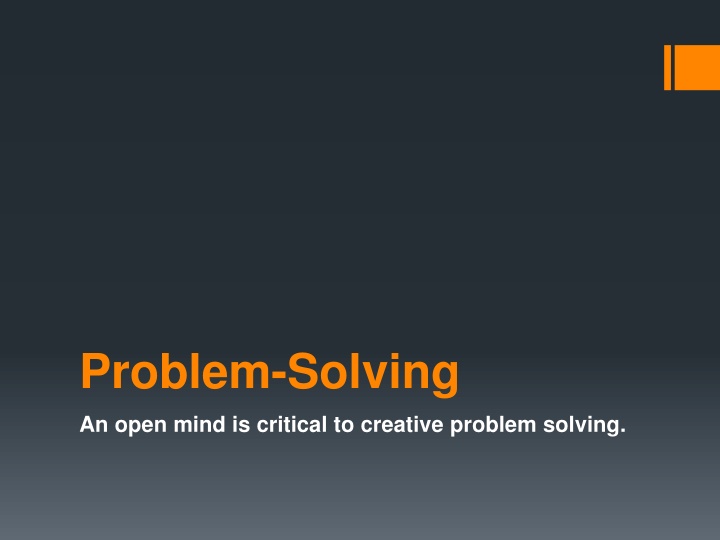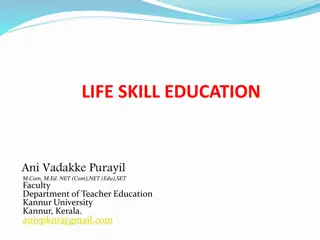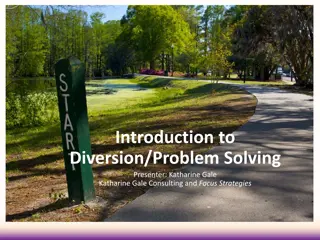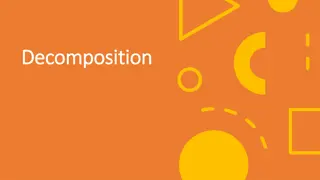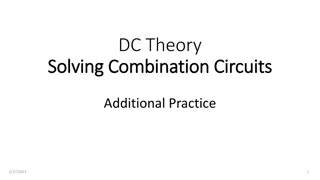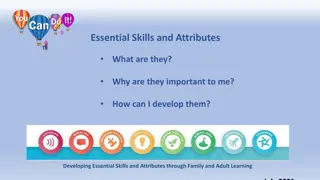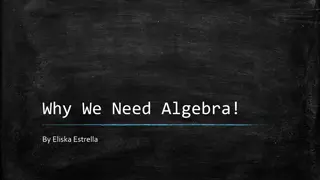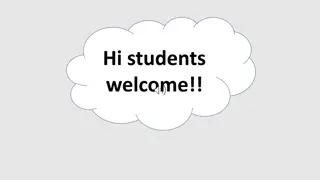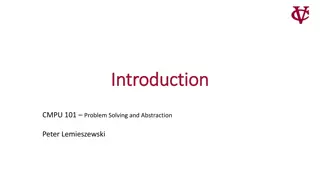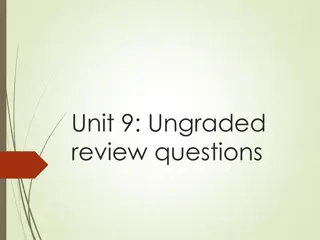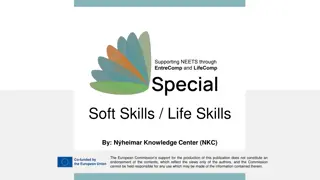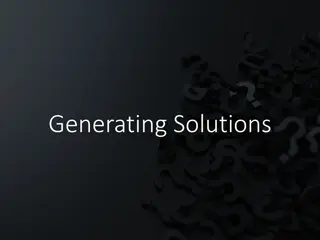The Importance of Problem-Solving Skills in Everyday Life
Developing effective problem-solving skills is crucial as they play a significant role in various aspects of our daily lives, from simple tasks to complex challenges. This article explores the significance of problem-solving, provides strategies like algorithms and heuristics, discusses obstacles encountered during the problem-solving process, and emphasizes the need for an open mind to foster creative solutions.
Download Presentation

Please find below an Image/Link to download the presentation.
The content on the website is provided AS IS for your information and personal use only. It may not be sold, licensed, or shared on other websites without obtaining consent from the author.If you encounter any issues during the download, it is possible that the publisher has removed the file from their server.
You are allowed to download the files provided on this website for personal or commercial use, subject to the condition that they are used lawfully. All files are the property of their respective owners.
The content on the website is provided AS IS for your information and personal use only. It may not be sold, licensed, or shared on other websites without obtaining consent from the author.
E N D
Presentation Transcript
Problem-Solving An open mind is critical to creative problem solving.
9 Dots Problem Connect the dots by drawing four straight, continuous lines that pass through each of the nine dots, and never lifting the pencil from the paper.
9 Dots Problem: A Possible Solution
Problem-Solving From organizing your DVD collection to deciding to buy a house, problem-solving makes up a large part of daily life. Problems can range from small (solving a single math equation to very large (planning your career). Before problem-solving can occur, it is important to first understand the exact nature of the problem itself. If your understanding of the issue if faulty, your attempts to resolve it will also be incorrect or flawed.
Problem-Solving Strategies As a student your life is busy with a wide range of activities related to school, home, work, and friends. Throughout the course of any given day, you handle a variety of decisions and problems automatically. At times, however, situations arise which you cannot solve automatically. In those situations the use of problem-solving skills becomes an invaluable asset that allows you to make the best choices and decisions available. In addition, problem-solving is a life skill that will serve you well throughout your life.
Problem-Solving Strategies Algorithms: A step-by-step procedure that will always produce a correct solution. Heuristics: A strategy that may or may not work in certain situations. Unlike algorithms, heuristics do not always guarantee a correct solution. Trial-and-Error: Involves trying a number of different solutions and ruling out those that do not work. This approach can be a good option if you have a very limited number of options available. Insight: A solution to a problem can appear as a sudden insight. According to researchers, insight can occur because you realize that the problem is actually similar to something that you have dealt with in the past, but in most cases the underlying mental processes that lead to insight happen outside of awareness.
Problems and Obstacles in Problem-Solving Of course, problem-solving is not a flawless process. There are a number of different obstacles that can interfere with our ability to solve a problem quickly and efficiently. Researchers have described a number of these mental obstacles, which include functional fixedness, irrelevant information and assumptions.
Problems and Obstacles in Problem-Solving Functional Fixedness: The tendency to view problems only in their customary manner. Irrelevant or Misleading Information: When you are trying to solve a problem, it is important to distinguish between information that is relevant to the issue and irrelevant data that can lead to faulty solutions. Assumptions: When dealing with a problem, people often make assumptions about the constraints and obstacles that prevent certain solutions. Mental Set: The tendency people have to only use solutions that have worked in the past rather than looking for alternative ideas.
How many squares do you see? Try it on your own and write down how many you see.
What exactly is problem- solving? Itis a mental process that involves discovering, analyzing and solving problems. The ultimate goal of problem-solving is to overcome obstacles and find a solution that best resolves the issue. The best strategy for solving a problem depends largely on the unique situation. In some cases, people are better off learning everything they can about the issue and then using factual knowledge to come up with a solution. In other instances, creativity and insight are the best options.
Try this one to get the creativity flowing In groups of two or three, use 6 popsicle sticks to make 4 equilateral triangles. Communicate openly with your partners.
Speed Bump Problem Every working day I experience at least 14 speed bumps on my way to and from work, and feel that there is a problem.
The Steps in Problem-Solving In order to correctly solve a problem, it is important to follow a series of steps. Many researchers refer to this as the problem-solving cycle, which includes developing strategies and organizing knowledge. While this cycle is portrayed sequentially, people rarely follow a rigid series of steps to find a solution. Instead, we often skip steps or even go back through steps multiple times until the desired solution is reached.
Identifying the Problem: In some cases, people might mistakenly identify the wrong source of a problem, which will make attempts to solve it inefficient or even useless. Identify/clarify this problem.
Questions to ask regarding the speed bump issue: What is the problem? What assumptions am I making about this? How can I get more information about this? How will I know it s no longer a problem?
Defining the Problem: After the problem has been identified, it is important to fully define the problem so that it can be solved.
Questions to ask regarding the speed bump issue: What will happen if I ignore the problem? How can I improve because of this? What are the good things about this problem? Is it really a problem? Who can help me solve it? Why is this important to driving/traffic? Why is this important to drivers?
Forming a Strategy: The next step is to develop a strategy to solve the problem.
Questions to ask regarding the speed bump issue: How is this problem affecting me? How is this problem affecting other people? Who else is experiencing this problem? How do other people deal with this problem?
Organizing Information: The more information that is available, the better prepared we will be to come up with an accurate solution.
Questions to ask regarding the speed bump issue: Is it relevant to my situation? Is it realistic? Is it manageable? What are the consequences both good and bad? What is the likelihood that it is going to help me reach my goal?
Allocating Resources: Determine how high priority the problem is.
Implementing and Monitoring Progress: If you are not making good progress toward reaching your goal, reevaluate your approach or look for new strategies.
Evaluating the Results: Evaluate the results to determine if it is the best possible solution to the problem.
Questions to ask regarding the speed bump issue: How effective is the solution? Did it achieve what I wanted? What consequences (good and bad) did it have in my situation?
Analytical thinking and problem-solving skills are part of many jobs, ranging from drafting, computer programming, welding and even to creative occupations such as art, acting, and writing. The following steps describe some approaches and how to improve your problem-solving skills using them. How to Improve Problem Solving Skills
Alert people affected by the problem. This gives them a stake in resolving it. As you work through possible solutions, keep these people informed of your progress. This lets them know what to expect and when to expect it. Be as optimistic as you can, but also as realistic as you can.
Define the problem clearly. Avoid making snap judgments based on a few symptoms but look for root causes whenever possible. Poor performance may not be caused by an individual's lack of skills but by ineffective communication of expectations and insufficient training in how to meet those expectations.
Brainstorming. Brainstorming is the generation and recording of ideas as they occur to you, either alone or in a group. You do this for a set period of time, then go through the list of solutions to evaluate their suitability. This technique is used to encourage participation from each member of the team. Brainstorming helps to break people out of the typical mode of approaching things to produce new and creative ideas. It creates a climate of freedom and openness, which encourages an increased quantity of ideas.
Gather information. Coupled with clearly defining a problem is gathering information about it. This may meaning consulting with people closer to certain aspects of the problem to get a proper grasp of its scope, or researching similar situations elsewhere to see what the root causes of those problems were and how they were resolved, if at all.
Root Cause Analysis AKA the "Five Why's." The objective of Root Cause Analysis is to find the fundamental cause for a problem. One way is to ask "Why?" five times or more to really get at the root of the problem.
Get feedback. While this step should be implemented while testing prospective solutions, it is also helpful to continue getting feedback to verify that the best solution will perform as expected and to find ways to adjust it if it isn't.
References Hands-On Activities for Innovative Problem-Solving by Daniel Raviv http://www.stanford.edu/group/ree/archives/archive07/usa/notes/ 2004-897_Final.pdf 6 Ways to Enhance Your Problem-Solving Skills http://www.lifehack.org/articles/productivity/6-ways-to-enhance- your-problem-solving-skills.html How to Sharpen Your Problem-Solving Skills by John Morgan http://johnmichaelmorgan.com/how-to-sharpen-your-problem- solving-skills/ NDT Resource Center Problem-Solving Skills http://www.ndt- ed.org/TeachingResources/ClassroomTips/Problem-solving.htm Lorraine County Community College http://www.lorainccc.edu/current+students/advising+and+couns eling/counseling/problem+solving.htm What is Problem-Solving? By Kendra Cherry http://psychology.about.com/od/problemsolving/f/problem- solving-steps.htm
